I mentioned in my review of Monster Hunter Generations that the series was about to change, and World was what I had in mind when I said that. World, as the name suggests, put a focus on the landscape, with bigger, more continuous environments than any prior game. With a focus on exploration and a huge, living ecosystem, World added the series’ first non-combative wildlife, animals that only existed to provide atmosphere. The result was a game that felt more real than any before, even if the actual monster count was lower than some earlier games. So let’s start with these minor critters, and see what forms the base of the food chain in this alien ecosystem.
Wiggler
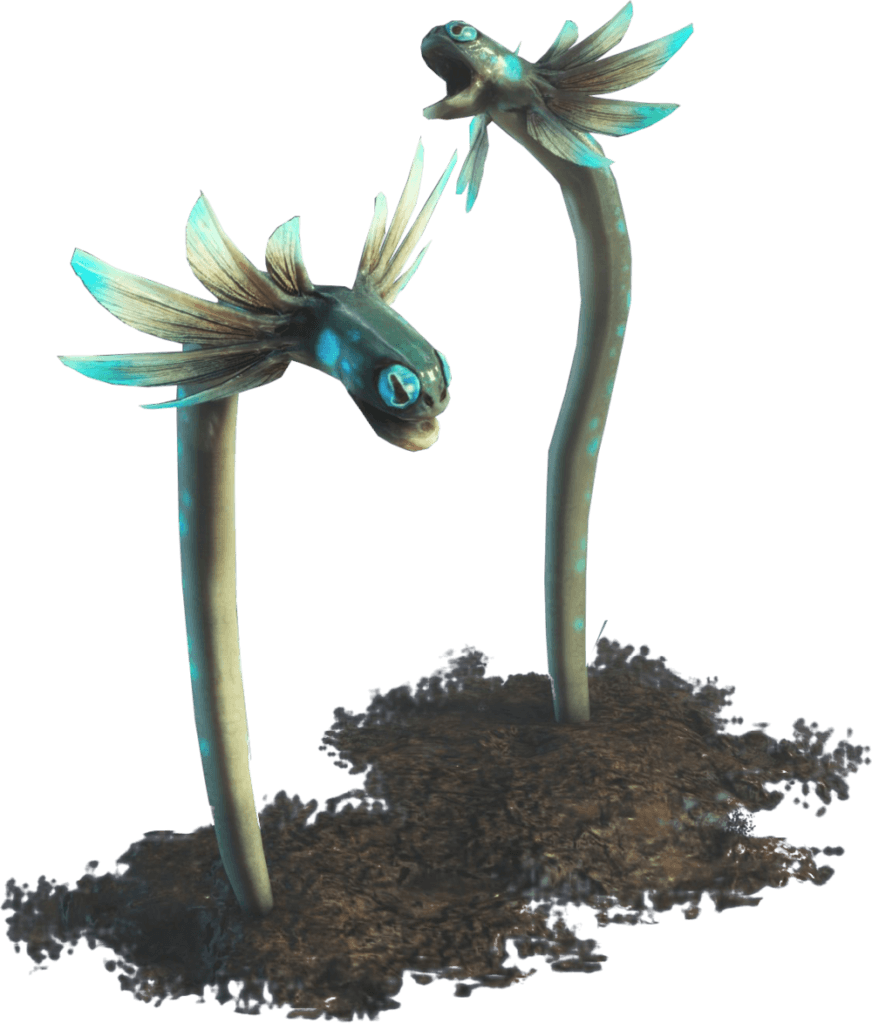
We’ll start with everybody’s favorite, the wiggler! The wiggler is clearly based on garden eels, which are pretty popular in Japan, but they’re gorgeously elaborated on here. I love their vibrant eyes and strange fins. The wigglers, like their real-life counterparts, are shy burrowers, and retreat into their burrows when approached. I always love creatures that are based on real animals, but displaced into alien environments, and as simple as these are, they’re really neat as well! You can also catch them (along with any other small animal in the game!) and put them in pots like plants!
Paratoad
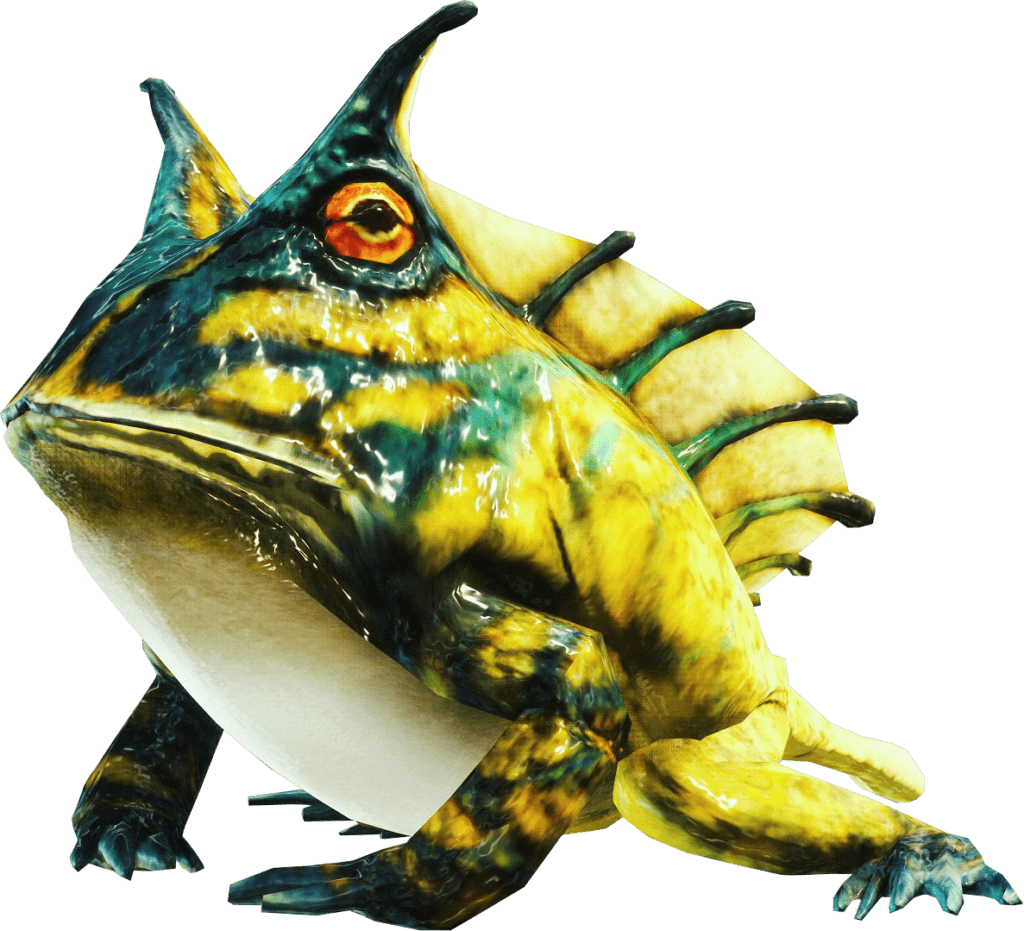
Want your players to love a critter in your game? Make them useful. Paratoads, when struck, release a paralytic gas that stuns monsters (and the player if they’re not careful). They’re pretty popular, which thrills me. Frogs have really broken through to the masses as cute animals. They’re pretty simple, resembling some South American horned frogs with minor additions, but that’s a good frog to look like, and the frills are a little alien. The game has a few color-swapped variants, but I like the basic yellow of the paratoad the most.
Grandfather Mantagrell
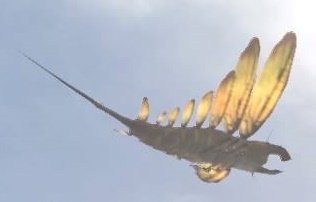
Always staying high, high in the air, it’s remarkably difficult to find a decent picture of a grandfather mantagrell. As the name suggests, these creatures are in part patterned after manta rays, or at least that’s what their name suggests. I think they look more like anamalocaris, a long-extinct arthropod of the cambrian that had two protruding mouthparts and a series of paddles down each side just like the mantagrell! Whether a ray, an anamalocaris, or some combination of both, the mantagrell is a very alien creature, a lot weirder than most Monster Hunter creatures get. I always like that.
Moon Slug

In the Iceborne expansion, another fish out of water was added in the form of the moon slug. While there are aerial jellyfish in the same area as wigglers and mantagrells, these are a little more special to me. This is mostly because, as their name suggests, they aren’t jellyfish at all, but mollusks! They’re clearly based on sea angels, a type of free-swimming sea slug popular in Japan. Even so, they’re quite elaborated, with a beautiful skirt of flesh that they swim with instead of just two small fins. I also adore their colors, with that frosty blue flesh matched by the warm glow of its inner organs. Beautiful little guys.
Duffel Penguin
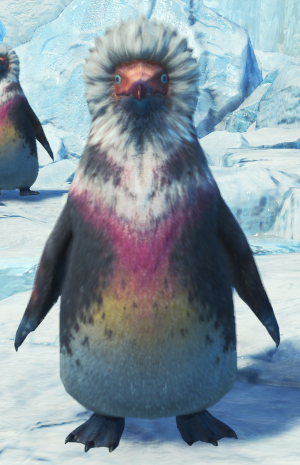
Duffel penguins elaborate less on their animal basis, but they are gorgeous nonetheless. I love the incandescent plumage and the fact that their ruff clearly resembles a parka. That’s incredibly clever! Their almost vulturine bare heads are also very cool. Penguins are freakier than they look at first glance.
Scalebat
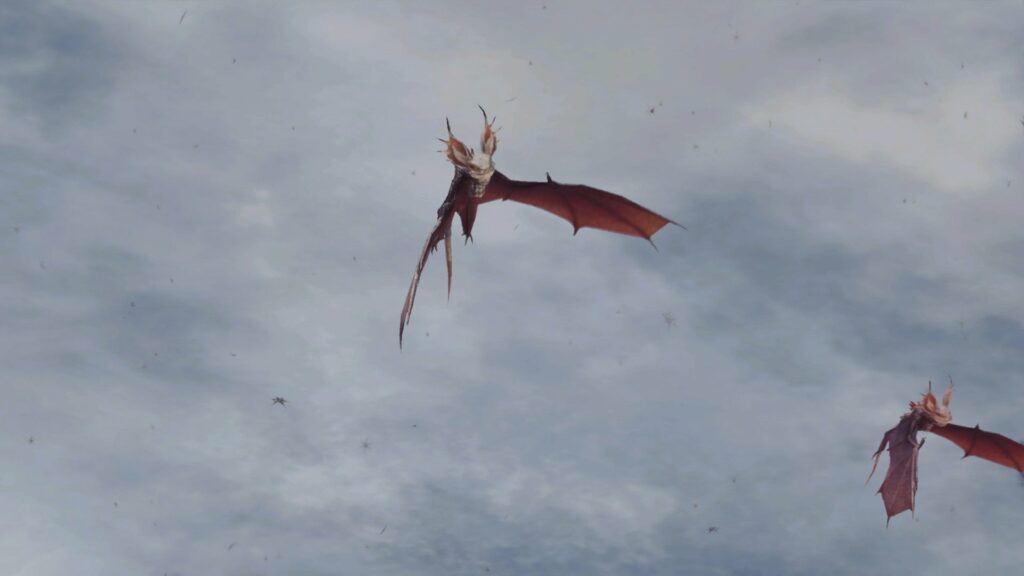
As the Monster Hunter world is dominated more by reptiles than by mammals, it makes a lot of sense that the ecological role of bats has been filled by tiny flying wyverns. It’s nearly impossible to get a good picture of them, but what we can see is pretty cute. Their face seems to be a little squished dragon face, and the spiny ears and long tail tell you they’re not ordinary mammals. Simple but neat!
Helmcrab
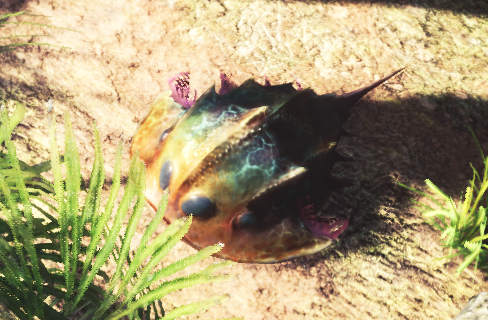
Helmcrabs are pretty much slightly more cartoonish horseshoe crabs, but they’re super cute. Those big eyes are just adorable, and I like the inclusion of the gills. It’s more like an axolotl, making them kind of an odd chimera. I want ten.
Climbing Joyperch
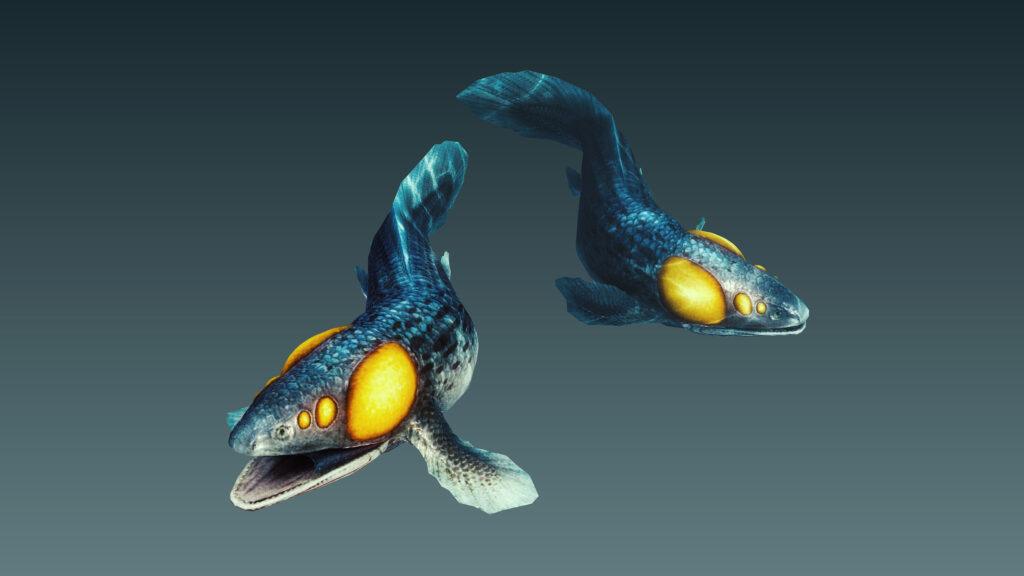
Oh my god it’s a Tiktaalik. For those who don’t know, that was a genus of lobe-finned fish from the Devonian period that had some early features of tetrapods, like a functional wrist and a flexible neck. It doesn’t differ much from the actual creature, but I like the vibrant yellow and blue color scheme. They prefer to hang out on land, but escape into the water when startled, which is a nice detail.
Andangler

Another amphibious fish, the andangler is obviously an anglerfish, with a lot of nice stlyization. The tiny little yellow eyes are cute, especially with that grumpy bulldog underbite. The lure looks a bit like fruit, which might be what it’s for, drawing land animals instead of fish.
Glass Parexus
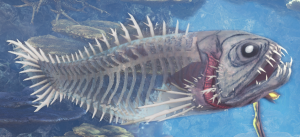
Gorgeous! I love everything about the glass parexus. The main gimmick, of course, is the transparent skin, letting us see its skeleton. That’s always a fun way to have a skeleton monster in a semi-grounded setting. Even besides that, the branching spines all over it and that toothy underbite are a lot of fun. The ghoulish grey flesh on its head is a good contrast with the exposed bones, especially with those spooky, deep-socketed eyes.
This is just a thin slice of the dozens of different creatures that flesh out the world of Monster Hunter like never before. Sadly, they lacked the development time to add quite so many new major monsters. Don’t get me wrong, there’s a lot of great new monsters, some of their best ever in fact, there just aren’t as many. As such, we’ll be including both the base game and the Icebourne expansion, which adds a whole new region and tons of extra monsters. With that said, let’s start with one of the fun twists of this entry in the series.
Jagras
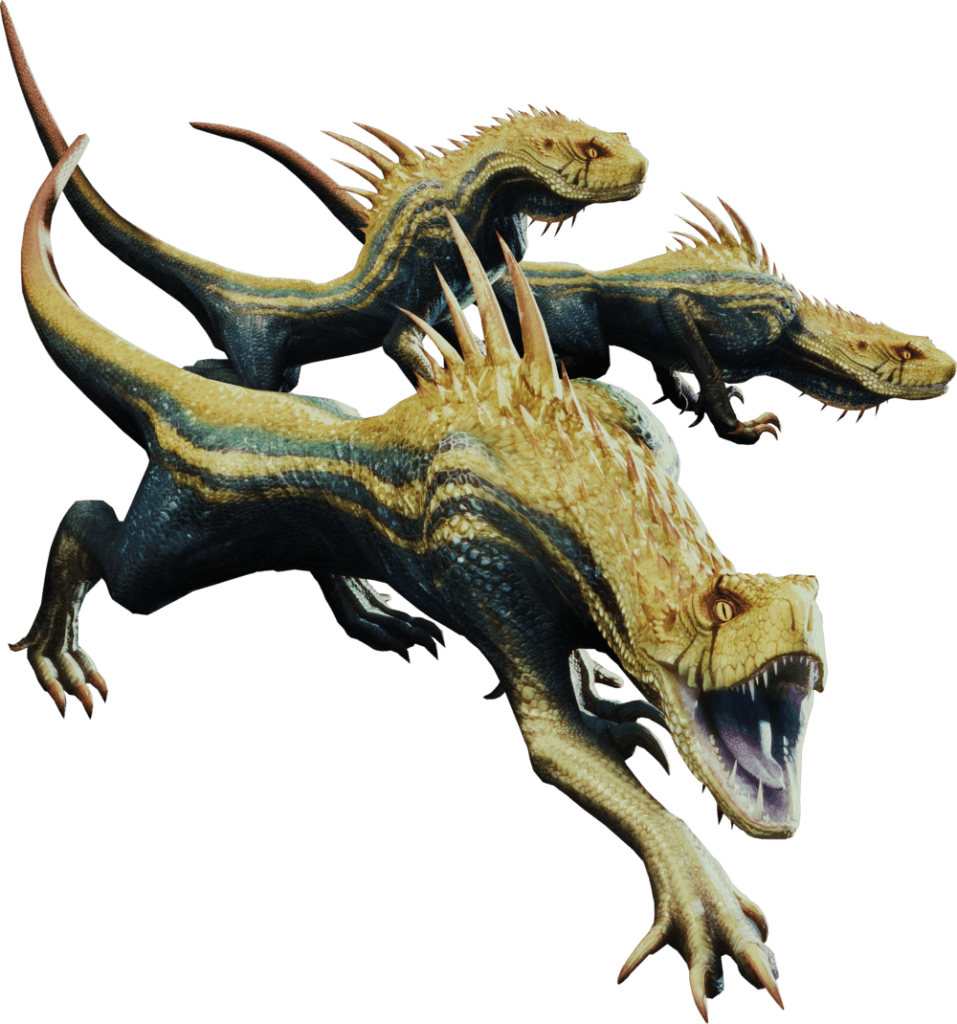
Monster Hunter World takes place on a mostly unexplored continent, labeled the “New World”. As such, while we do see many of the series classics, some of the various ecological roles of the world have been taken by different groups. In all the former games, the small, pack-hunting predators were all clearly based on raptors. In World, this role has been taken by the quadrupedal reptiles known as fanged wyverns! The first example we meet are the jagras, sleek cat-like reptiles with theropod skulls. Not a lot to say, but I like their color scheme.
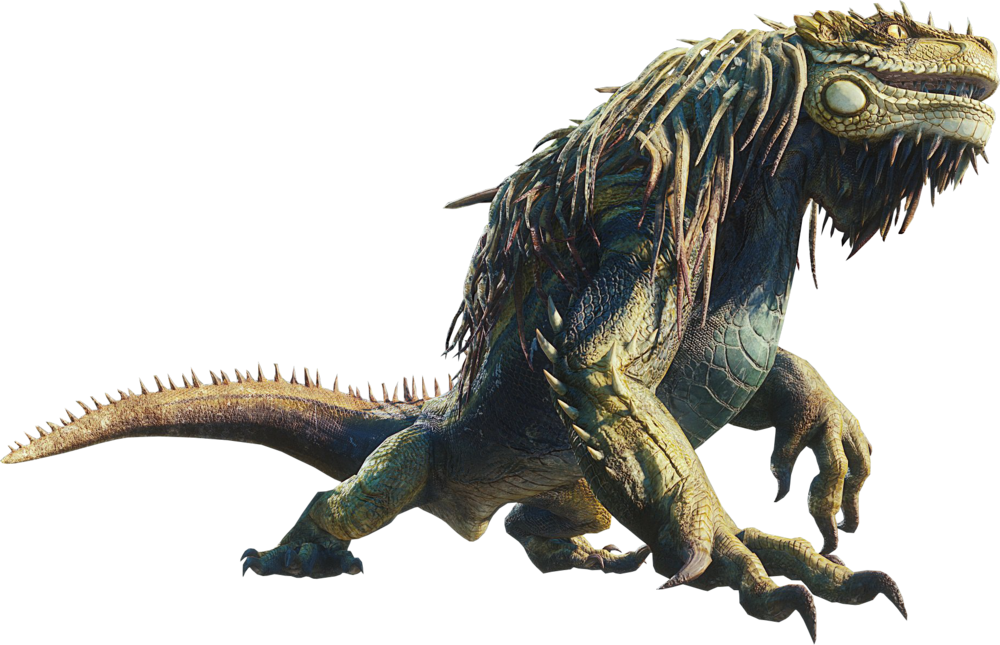
Just like the jaggis and their like of former games, the jagras have a larger, more powerful leader in the form of the great jagras. Immediately, this is one of my favorite monsters in the entire series. The crest scales of an iguana are turned into a floppy “mane” a brilliant design choice, and I love its cartoonish, gorilla-like proportions. The great jagras has even more love put into its personality. It swallows animals nearly its own size whole, swelling absurdly. When full, it slides on its stomach instead of running as normal. It can even spit up its prey at the hunter as an attack! Hilarious!
Girros
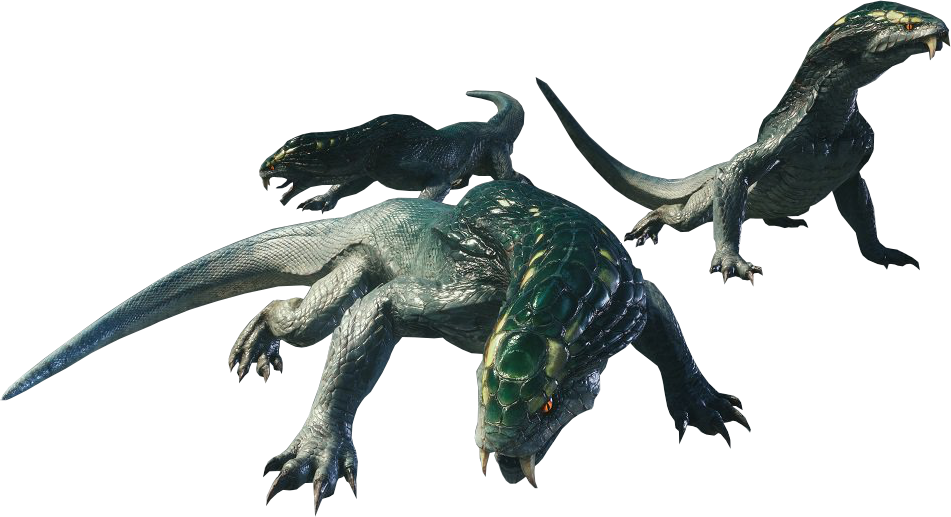
Our other fanged wyvern pack species is the girros, an inhabitant of the Rotten Vale, a horrific canyon where the dead bodies of animals above fall. The standard girros is pretty simple, with a body similar to a Komodo dragon and a sabertoothed head with cobra influences, but damn that color scheme. I like the green of the head a lot but I think I’d make the body a darker grey, given the choice.
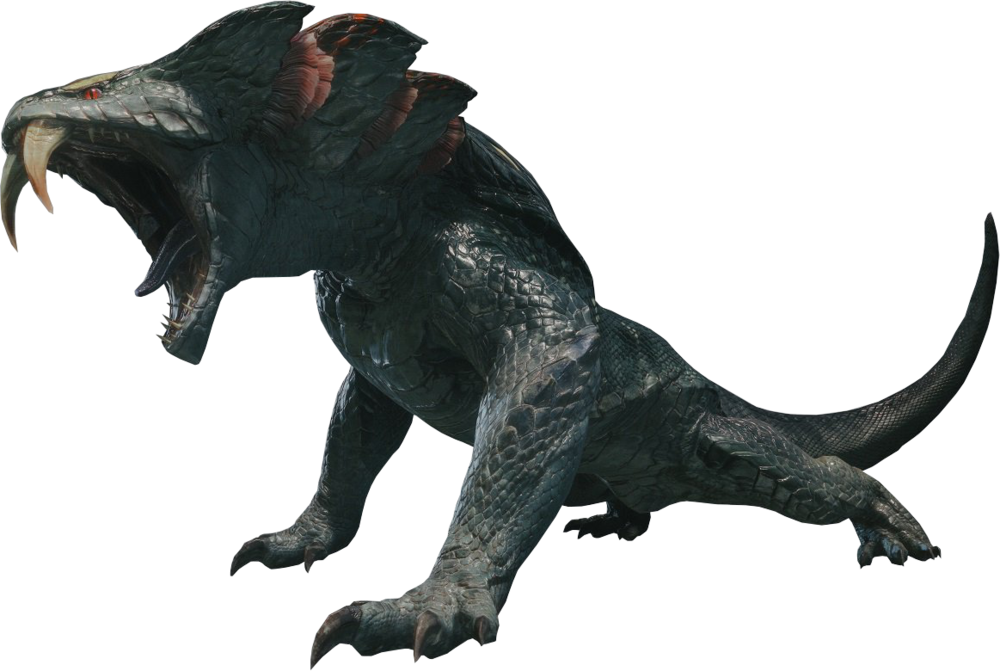 As such, I much prefer the great girros, with its dark grey turning nearly black in places! Otherwise it’s mostly the same, but with a more prominent hood that also shows off the unusual gills that it uses to filter out the poisonous air of its home territory. That’s a cool biological detail.
As such, I much prefer the great girros, with its dark grey turning nearly black in places! Otherwise it’s mostly the same, but with a more prominent hood that also shows off the unusual gills that it uses to filter out the poisonous air of its home territory. That’s a cool biological detail.
Tzitzi-Ya-Ku

With the pack-hunting roles taken by lizardy types, the bird wyverns of the New World are instead mid-sized scavengers and generalist solo hunters. I have a personal bias towards Tzitzi here because of how much it resembles a Dilophosaurus, one of my favorite dinosaurs, but it’s cool overall! Overall mostly rather simple and subtle, but for the dark purple hide and those feathers or fringed scales on its arms, but look at those fans! I love just how overly huge they are, and they’re used to create a blinding flash that the Tzitzi is only too happy to use on the larger, more dangerous predators in its environment. Look at that face, you just know this thing is a troublemaker.
Kulu-Ya-Ku
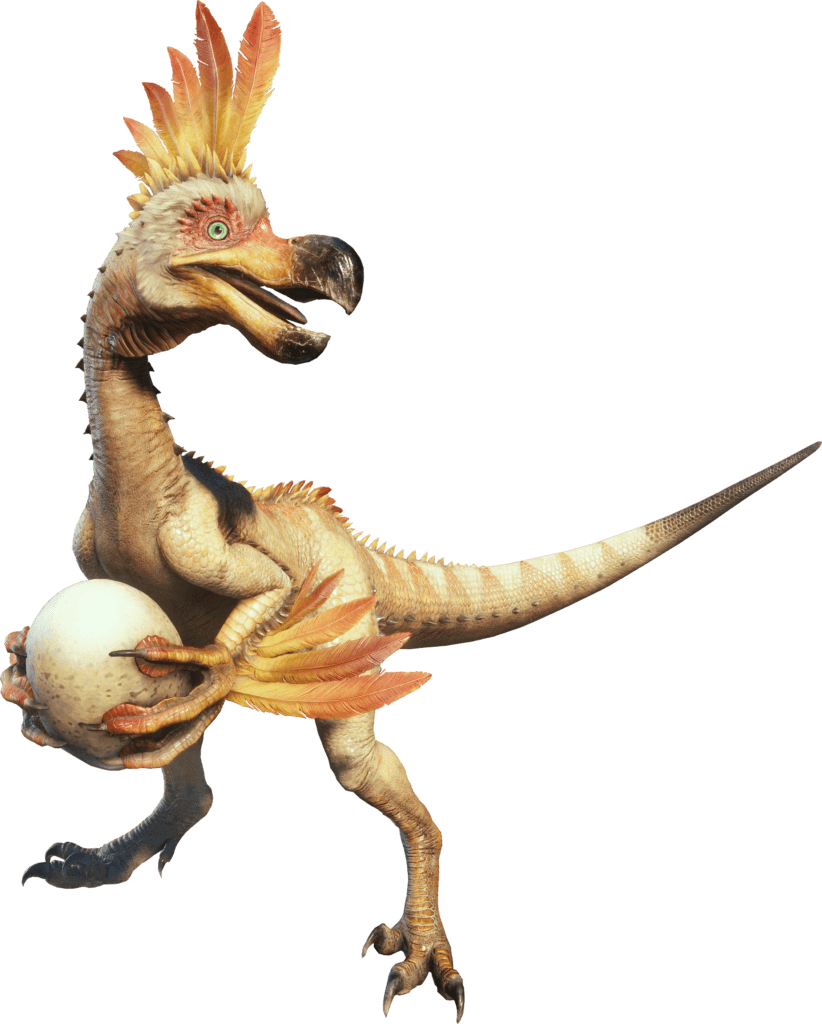
Kulu-Ya-Ku is great! As you can see here, they have fun little pads on their hands that make it easier for them to carry objects, allowing them to use tools. In a fight, they will pick up rocks and use them as weapons. Presumably they normally use that to smash eggs, and possibly hard-shelled fruits. My personal favorite feature is of course their huge dodo beak. Dodos need recognition for more than being an icon of extinction.
Dodogama

Dodogama is the most lizardy of the new fanged wyverns, making it extra wonderful that it captured the hearts of the game’s fanbase. Its plump body, clumsy movements, and little mindless eyes are all endearing even to mainstream folks! I’m happy that a fat lizard can be considered one of the cutest things in the game, up there with wigglers. I don’t have a whole lot to say about it besides, but it’s beautifully colored and I like that big shovel-like jaw it’s got going on.
Nightshade Paolumu
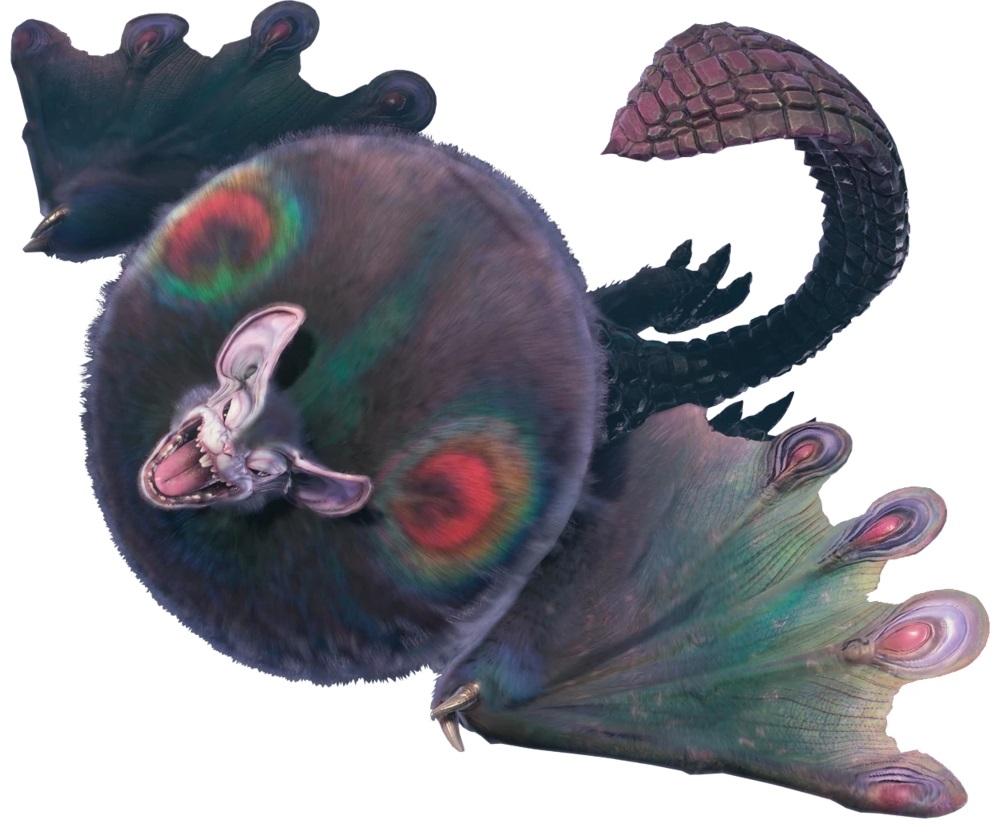
Paolumu is an odd one. Presumably, it’s a much more massive relative of the scalebats, but it actually looks more mammalian than they do, with differentiated teeth and thick fur. Whatever, it’s a fun design! Normally, the Paolumu’s neck is long and sleek like a regular flying wyvern’s, but it can puff up absurdly as we see here, filling with air. It’s ridiculous and adorable, and the tough tail is pretty fun too. The version depicted is the Nightshade Paolumu, a subspecies with a color pattern I like more. The base version doesn’t have those vibrant eyespots, something I assume draws attacks to its puffed-up neck, a target that can recover more easily than its head. World really goes the extra mile with its variant species!
Pukei-Pukei

Just looking at this nasty cutie, you can tell they’re poisonous. I love those huge gecko eyes, really the only feature on it directly taken from a real animal. Perhaps its wild crests are an exaggeration of the crested gecko? I like the balance to it, one vibrant, giant tongue at the front and a more subtly colored but anatomically stranger tail in the back. It’s a nozzle! It squirts poisonous sludge with it! Another feature that I only just noticed now that I put them together in this article is that their wings are nearly identical to Paolumu.
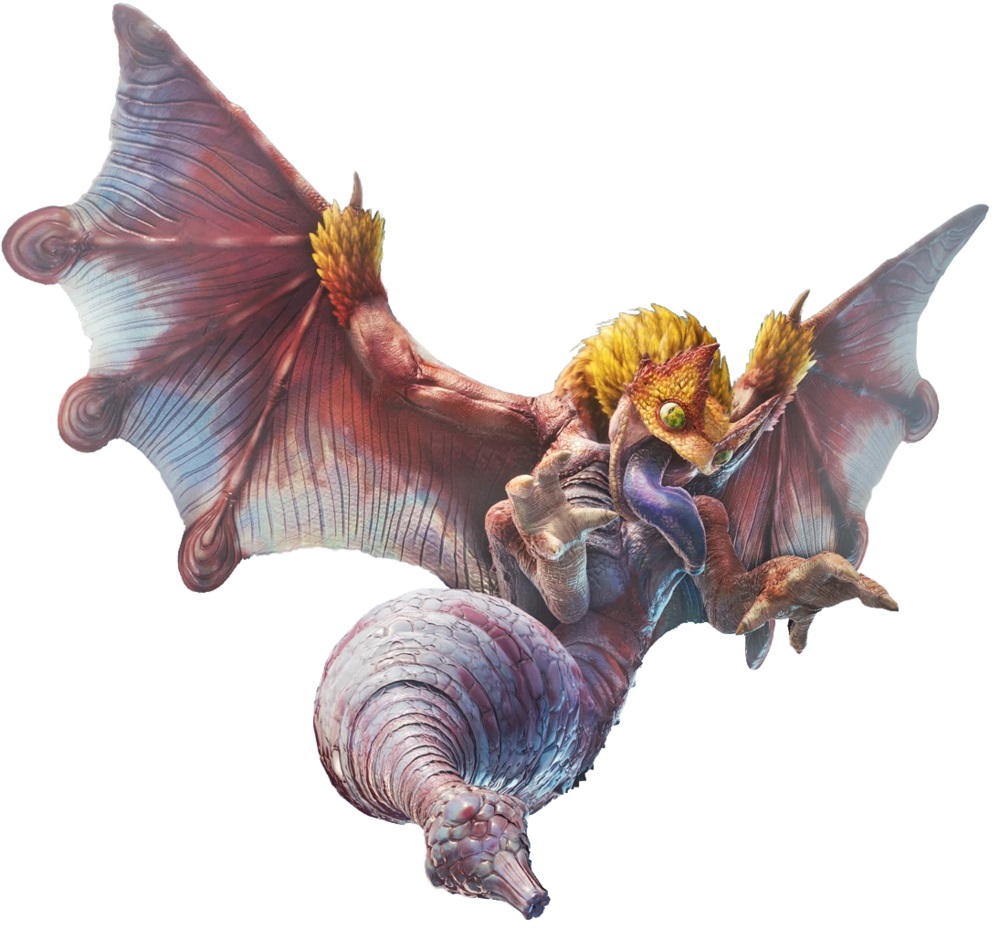
I’m not sure if I like the original or this variant, Coral Pukei-Pukei, more. I like those vibrant colors, but it makes the tongue and tail stand out less. In another fun twist on the original, this version fills its tail with water and fires it off at deadly velocity, using it as a water cutter.
Radobaan
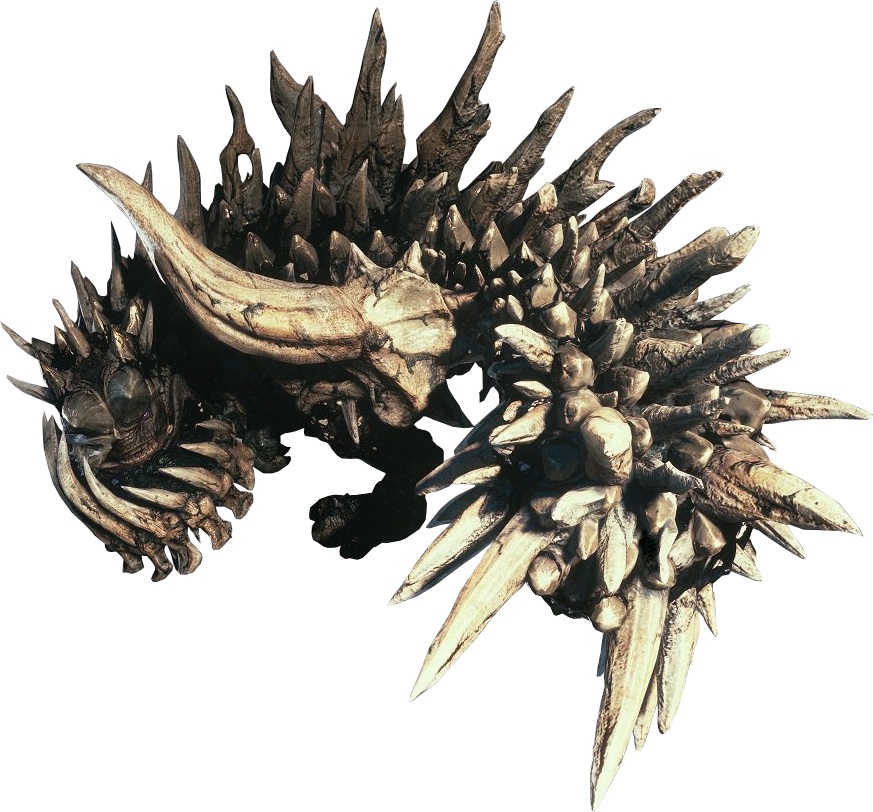
Radobaan is one of my absolute favorites in the entire series, not just because of its design but because of the thought but into its ecological niche. A close relative of Uragaan, Radobaan lacks the natural stone armor of its cousin and instead uses its tarry secretions to stick sharp bones to its body. It’s got horns from Diablos on its hips, which is cool, but my favorite feature is that spine on its jawline, giving it an assymetrical “cage” under its mouth. Another inhabitant of the Rotten Vale, Radobaan is a specialized bone consumer. The same adaptations Uragaan uses to eat stone and minerals, Radobaan is turning to process bone! I love that!
Odogaron

A more active predator of the same environment, Odogaron is another of my favorites. It reminds me just a little of the Permian apex predators known as the Gorgonopsids, especially with those large, protruding canines, but overall it’s a very unique beast. The gnarled flesh looks almost carved, and really does have a vulture-like look, emphasizing its scavenging nature. Most unique, however, are those nested claws. It’s not explicit, but I feel like they use the shorter, blunter claws for traction while running and climbing, while keeping their long blades at the ready for slicing up prey. Most animals can only use their claws either for locomotion or attack, but Odogaron can use them for both. Cool!
Odogaron, however, is often seen carrying meat around, taking it away from where it made its kills. Dominant predators don’t do this, because they can defend their kills. What does Odogaron think is going to take its food?
Vaal Hazak
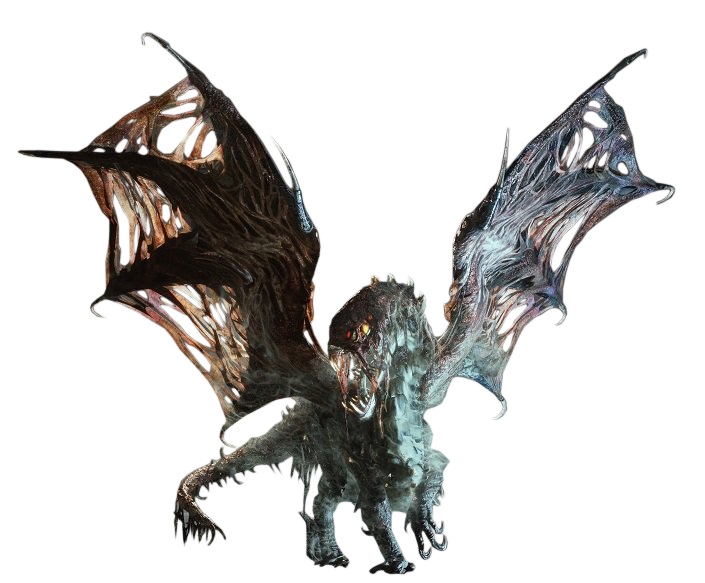
This is it, the apex predator of the Rotten Vale. Like other Elder Dragons, Vaal Hazak is able to push a little further into outright fantasy territory. Rotting flesh, possibly its own, is draped over its body, and even its wings are hopelessly rotted away. Most unusually, its lower jaw is lacking in flesh, like its own toxic breath (so strong it pollutes the entire Rotten Vale) has rotted it to the bone. It’s not just the closest the series can get to a zombie dragon, it’s also incorporating elements of actual deep-sea fish! Brilliant!
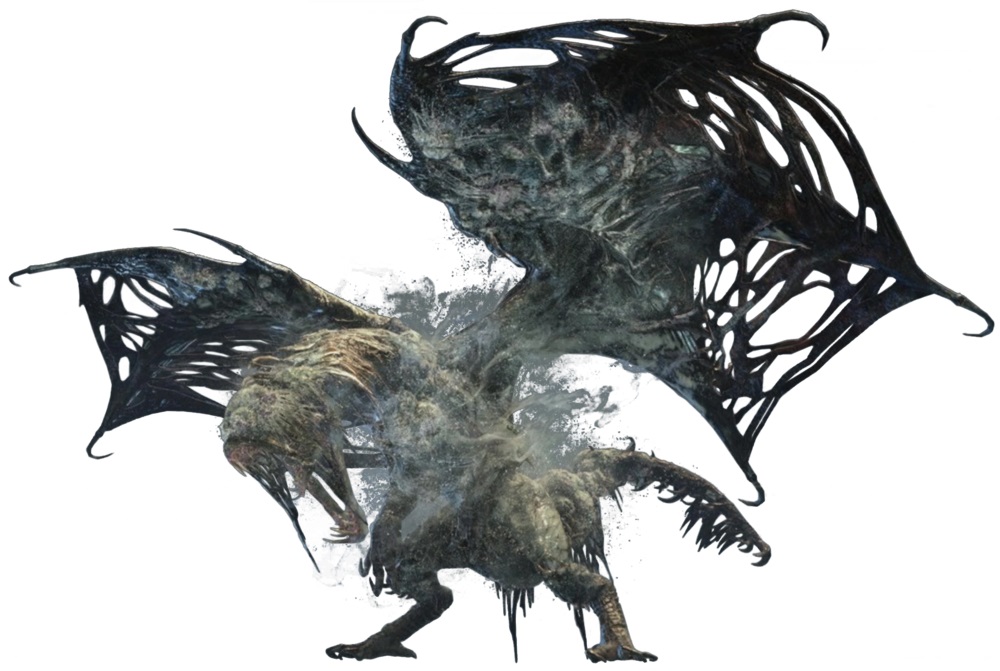
I like the Blackveil variant of the species even more. I love that thick layer of mold all over its body. That’s good, Resident Evil 7 level mold. Blackveil is also non-aggressive and only attacks when you start the fight, suggesting it might rely on the way it poisons its environment to kill animals, then just scavenges the decimated landscape. It’s not confirmed, but that’s my personal hypothesis.
Namielle
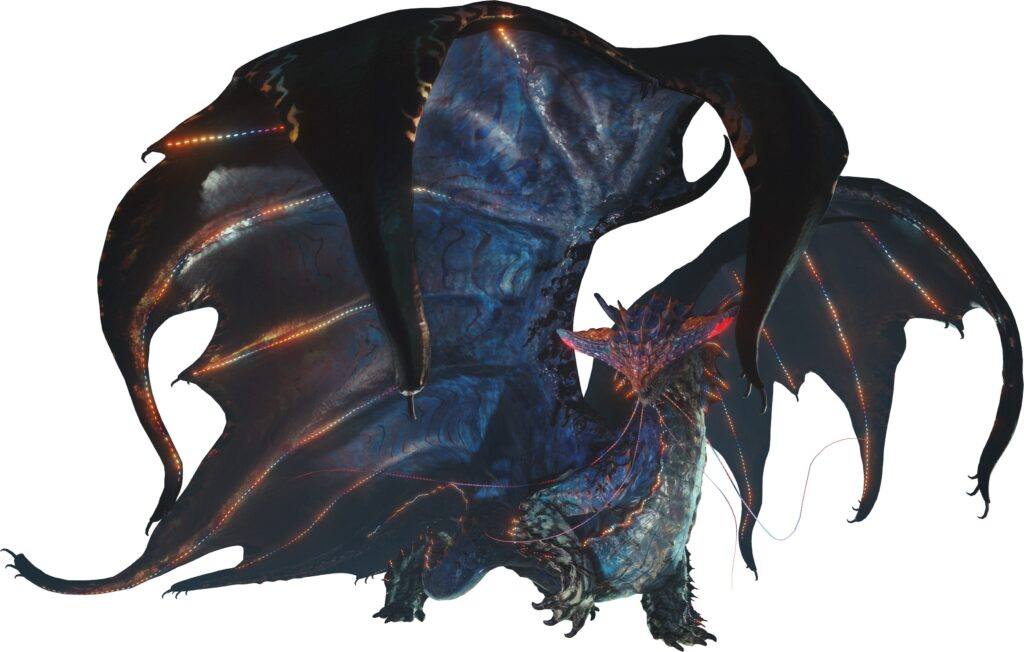
While no leviathans made it into World, they did add my favorite ever nautical monster in the series. Namielle has a lot of charm points. Its squat limbs and the lines down its body are a lot like the world’s larger salamanders, and the head evokes the prehistoric amphibian Diplocaulus. My favorite feature, however, is its bioluminescence. The specific colors and patterns going down its fascinating wings and whiskers are closest to some species of comb jellies in the real world, a really cool feature to put into a dragon. This really does come across as a creature that dwells extraordinarily deep in the ocean most of the time.
Bazelgeuse
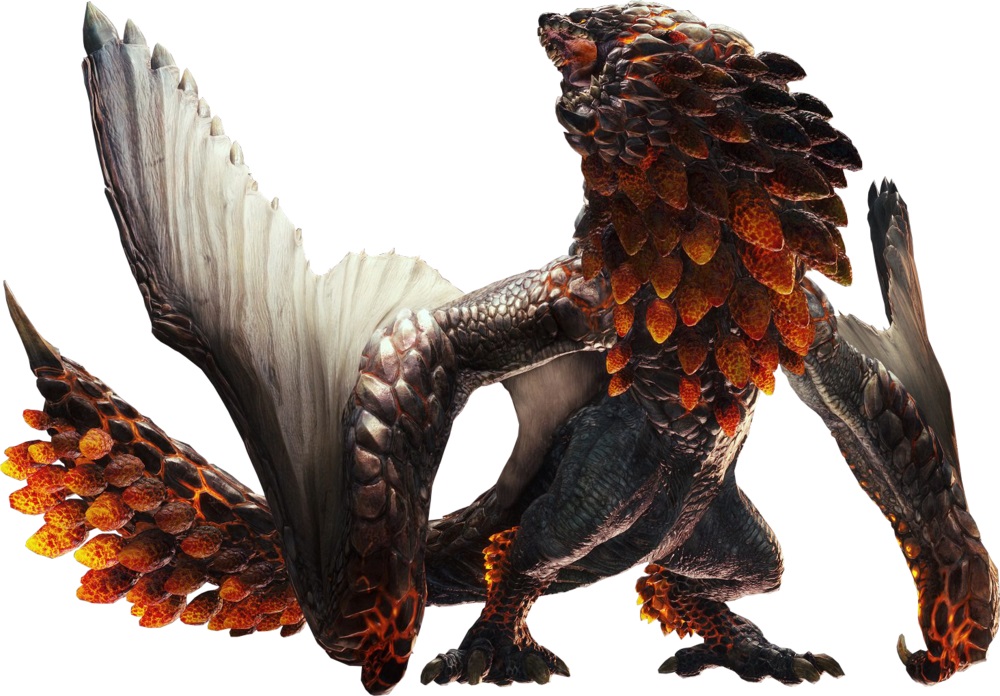
Before we reach our final Elder Dragon, and the one most emblematic of World’s creativity, we have two nasty new critters to cover. First is Bazelgeuse, a flying wyvern whose scales have developed into nasty bombs it can drop on those beneath it. It’s not the most complex design, but it’s a really fun one, especially with its sleeker, shorter body and sharp wings making it look like a modern military jet. I also like the short, pugnacious snout and the “mane” of explosive scales on its neck. Look at that haughty jerk!
Anjanath
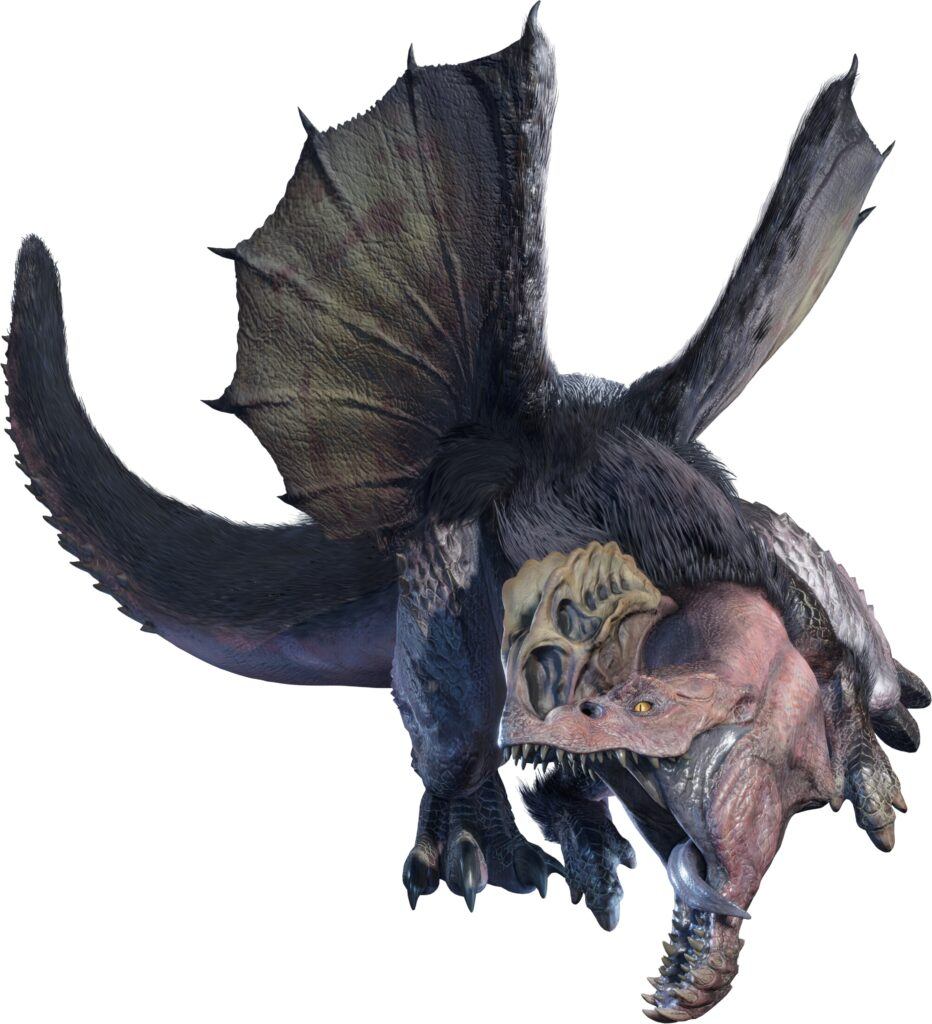
Sometimes it’s the simple monsters that get me. There’s a lot of good things about Anjanath. The fleshy, inflatable crest on its face is very cool. So are the flared wings, reminiscent of a medieval dragon. But what gets me is the integument. A monster based on a large predatory dinosaur actually gets to have feathers. It’s a rare sight! I love their placement, too. Leave that head and neck mostly bare like a giant, violent vulture. It’s a classic dinosaur-style Monster Hunter creature with a modern twist.
Shara Ishvalda
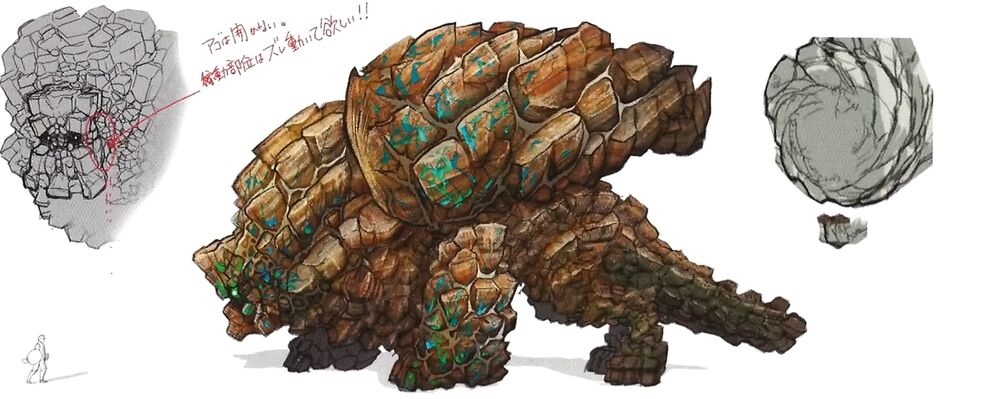
We’re ending our article with another elder dragon. I find the standard ones a little dull, but World knocks them out of the park. On the surface, Shara Ishvalda is cute but not revolutionary, just a stony dragon. We’ve seen this look multiple times in this series alone, although Shara does stand out for its adorable glowing eyes, peeping out of the holes in its armor. However, this is just the start. In battling it, the player will force it to shed its stony armor, revealing its true form.
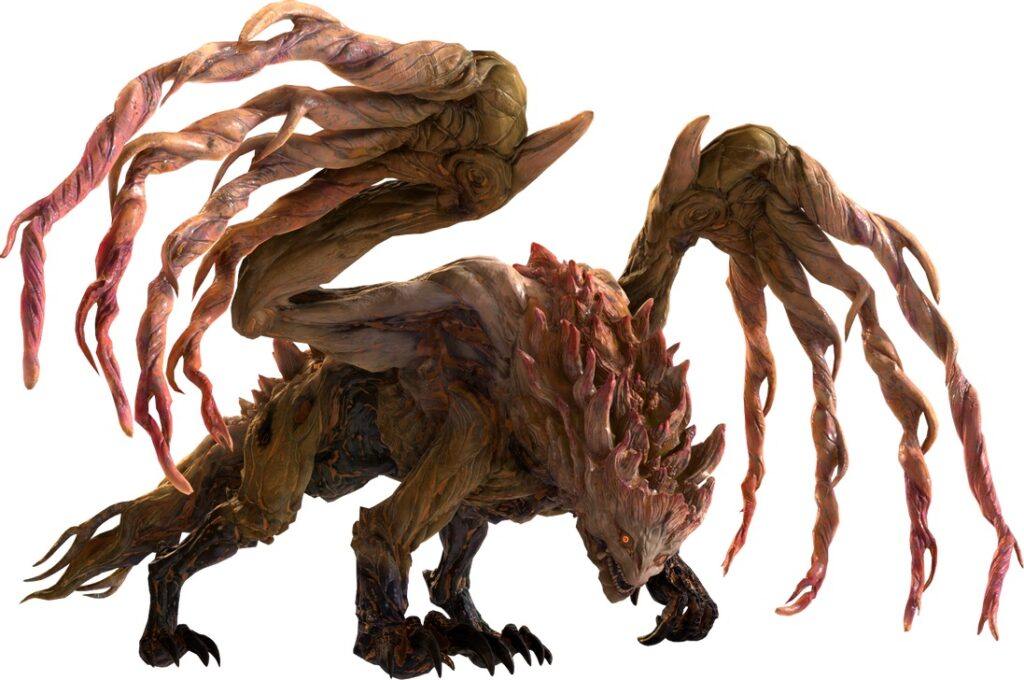
Render by Yare-Yare-Dong, showing off the anatomy of the wings better than any official images I can find.
Like many games, Monster Hunter saves work by using the same skeleton for many of its monsters. Shara has the same skeleton as the other major elder dragon of the game, Xeno’jiiva, but plays with it in a way I don’t think I’ve ever seen. Shara has completely lost the membranes allowing it to fly, and instead holds its wings more like hands. The “fingers” are used as weapons, releasing vibrations that turn the ground into quicksand and hurt any hunter struck by it. I love how they look too, gnarled and ropey, like exposed tendons. The entire creature looks a little mummified, emphasizing just how ancient and alien this thing is.
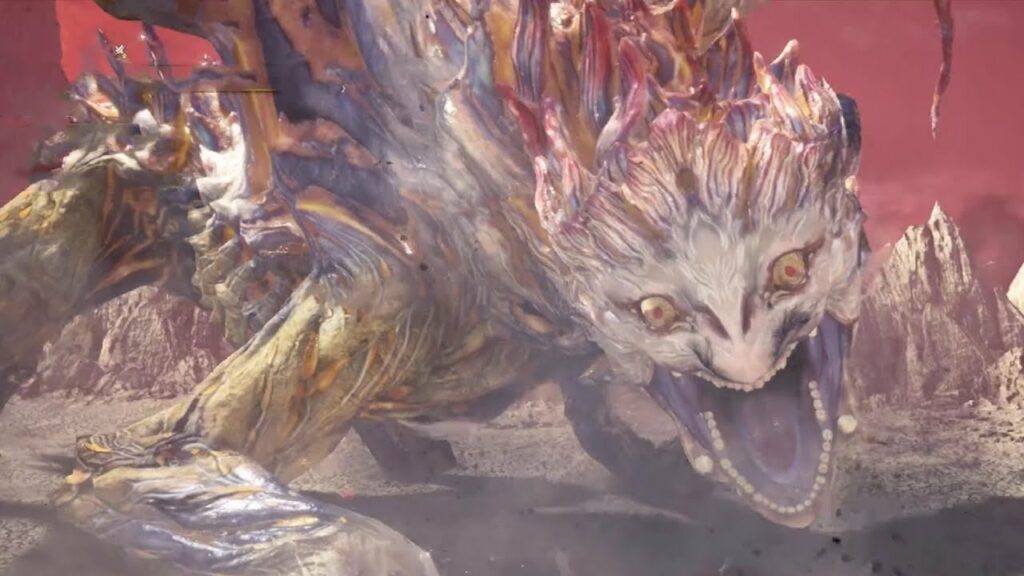
Its face really shows off that dried look. That horrible stare is genuinely unsettling, especially given that the monster almost never looks directly at the player character but instead stares into the camera. Those teeth make it even worse. A big mouthful of fangs is never as scary as little peg teeth.
Shara Ishvalda isn’t my favorite monster I’ve ever seen from the series, but it’s one of the wildest final bosses they’ve thrown at us. I love that this many monsters in, they’re still coming up with new, strange things to throw at us. As of writing this article, I haven’t yet played Monster Hunter Rise, but you can trust that an article will come when all of its monsters are released!
